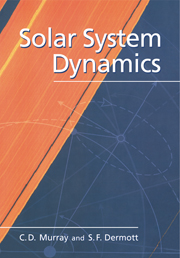Book contents
- Frontmatter
- Contents
- Preface
- 1 Structure of the Solar System
- 2 The Two-Body Problem
- 3 The Restricted Three-Body Problem
- 4 Tides, Rotation, and Shape
- 5 Spin–Orbit Coupling
- 6 The Disturbing Function
- 7 Secular Perturbations
- 8 Resonant Perturbations
- 9 Chaos and Long-Term Evolution
- 10 Planetary Rings
- Appendix A Solar System Data
- Appendix B Expansion of the Disturbing Function
- References
- Index
3 - The Restricted Three-Body Problem
Published online by Cambridge University Press: 05 June 2012
- Frontmatter
- Contents
- Preface
- 1 Structure of the Solar System
- 2 The Two-Body Problem
- 3 The Restricted Three-Body Problem
- 4 Tides, Rotation, and Shape
- 5 Spin–Orbit Coupling
- 6 The Disturbing Function
- 7 Secular Perturbations
- 8 Resonant Perturbations
- 9 Chaos and Long-Term Evolution
- 10 Planetary Rings
- Appendix A Solar System Data
- Appendix B Expansion of the Disturbing Function
- References
- Index
Summary
Two's company, three's a crowd.
Proverb
Introduction
In Chapter 2 we showed how the problem of the motion of two masses moving under their mutual gravitational attraction can be solved analytically and that the resulting motion is always confined to fixed geometrical paths that are closed in inertial space. We will now extend our analysis to consider the gravitational interaction of three bodies, paying particular attention to the problem in which the third body has negligible mass compared with the other two.
The simplicity and elusiveness of the three-body problem in its various forms have attracted the attention of mathematicians for centuries. Among the giants of mathematics who have tackled the problem and made important contributions are Euler, Lagrange, Laplace, Jacobi, Le Verrier, Hamilton, Poincaré, and Birkhoff. The books by Szebehely (1967) and Marchal (1990) provide authoritative coverage of the literature on the subject as well as derivations of the important results. Today the three-body problem is as enigmatic as ever and although much has been discovered already, the recent developments in nonlinear dynamics and the spur of new observations in the solar system have meant a resurgence of interest in the problem and the derivation of new results.
If two of the bodies in the problem move in circular, coplanar orbits about their common centre of mass and the mass of the third body is too small to affect the motion of the other two bodies, the problem of the motion of the third body is called the circular, restricted, three-body problem.
- Type
- Chapter
- Information
- Solar System Dynamics , pp. 63 - 129Publisher: Cambridge University PressPrint publication year: 2000
- 1
- Cited by

